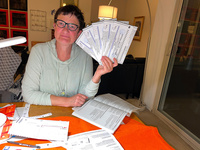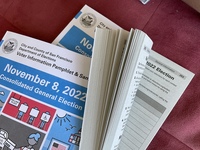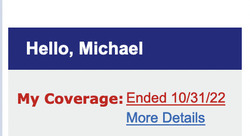 |
| Angelika/Mike Schilli |
|
|
|
Angelika If you are an American citizen, you are allowed to participate in elections at the local, state, and federal levels. But how does it work exactly? The organization and execution of elections is in the hands of the individual states, with individual regulations. In almost all states, the eligible voter can only participate in the election if they have registered as a voter. Once our citizenship was finalized, we immediately registered to vote. In California, you can do this online, and Michael registered himself in the voter registry. He had to provide his name, date and place of birth, driver's license number, the last four digits of his social security number, and his address. A few weeks later, a card arrived in the mailbox with his voter number. At the time, I happened to have to renew my driver's license and I took care of the voter registration at the same time at the California DMV.
I was also sent the card with my number by regular mail. In California, voters must register at least 15 days before the election in order to participate. Once registered, this remains in effect and applies to all future elections, unless you move, change your name or your party preference (more on that later). Then you register again.
Eligible American voters who move from another state to California must also register to vote in California. If the eligible voter misses the deadline, they still have the option to go to their polling place on election day and vote. The vote will then be considered provisional until it is checked to see if the voter is eligible to vote in California.
When registering to vote, you are asked which party you identify with. The following are available to choose from: the Democratic or Republican Party, the Green Party, the Peace and Freedom Party, the "Libertarian" Party, and the "American Independent Party". In California, however, one can also check that you do not identify with any party. Note that registering with a party does not commit one to voting for it, but it may be relevant in different primaries: for example, those who register as affiliated with the Democratic Party can participate in its primaries to vote for the candidate the Democratic Party will send to the race. The same applies to Republicans.
Since the pandemic, California authorities have been automatically sending registered voters mail-in ballots. Everyone can therefore fill out the ballots in peace at home. Of course, there is still the option of going to the polling station on election day. If the voter opts for mail-in voting, the ballots are placed in a designated envelope. The envelope is sealed and signed on the outside. The signature serves as verification that the voter is the right person. Before the count, the signature on the envelope is compared with the one on the California driver's license of the voter. The voter gives his consent for this when registering to vote. The completed mail-in ballots can either be sent by post or placed in special ballot boxes, which look like mailboxes and are distributed throughout the city. We used one such box and threw our documents into it in our district. Interestingly, you can then track online where your ballot is and whether and when it was counted.
The voter turnout in the US is often low (on average a bit over 60% for presidential elections and about 50% for congressional elections). Since I'm allowed to vote here myself, I honestly don't find that surprising anymore. First of all, there's the aforementioned mandatory registration, which is quick but doesn't happen automatically. Then Michael and I spent an honest hour filling out our ballots in the last elections in November, because we were not only called upon to cast our vote for the congressional candidates, but also to vote on dozens of referendums. Thank God we were able to do this at our dining table at home and didn't have to stand in a voting booth.
In California, these referendums have become so widespread that the voter has to work through meters-long ballots and there are always some new referendums coming up. Even though we have only had our American citizenship since February 2022 and are thus eligible to vote, we have already participated in three elections in this time frame. In November, we had a whopping five ballots to work through, printed on double sided paper. We are both certainly not uninformed, quite the contrary, but for many things we were asked to decide on, one would have had to study the matter for weeks in order to make an sound decision. Then we asked ourselves what the politicians were actually doing in California, because after all, you elect a suitable representative for doing exactly this kind of work. We did receive information material in the form of a telephone book-thick volume, but that wasn't really helpful, as it lacks neutrality.
Every ballot initiative ("Proposition") lists pros and cons, but anyone can write and submit these documents in San Francisco, and they often come across as manipulative. Then there are associations and organizations as well as politicians who sponsor certain ballot initiatives and give their names to them. That's why so many pamphlets landed in our mailbox at home before the elections. A waste of paper like no other.
In San Francisco, there is the relatively new politically motivated association GrowSF.org, which, for example, publishes a voter guide that is quite useful. Sachin Agarwal founded GrowSF in 2020 with the goal of finding political solutions for San Francisco based on pragmatism and common sense. In general, it is simply impossible for voters to know all the facts. I can understand why some people are frustrated with the ballot paper chaos. This should be urgently reformed.
















